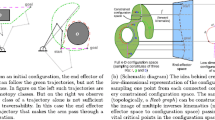Abstract
Motivated by navigation and control problems in robotics, Ghrist and Peterson introduced a class of non-positively curved (NPC) cubical complexes arising as configuration spaces of reconfigurable systems, best regarded as discretized state space representations of embodied agents such as a multi-jointed robotic arm. In current real world applications, agents are increasingly required to respond autonomously to sensory input in order for them to contend with a priori unknown obstacles to navigation. In particular, the configuration spaces in question may not be known in advance. This motivates the following problem formulation: Given a NPC cubical complex \(\mathcal {C}\) and a point-separating collection \(\varSigma \) of Boolean queries on its 0-skeleton, \(\mathcal {C}^{(0)}\), find an efficient algorithm for learning \(\mathcal {C}\) from the outputs provided by \(\varSigma \) along an appropriately chosen path in \(\mathcal {C}\). In this note, we tackle the problem of identifying \(\mathcal {C}\) when it is known that \(\mathcal {C}\) is CAT(0). We show that the collection of canonical hyperplanes of \(\mathcal {C}\) is the unique solution of a sub-modular minmax problem over the space of point-separating systems of Boolean queries on \(\mathcal {C}^{(0)}\), which may also be formulated in terms of the quadratic form associated with the graph Laplacian of \(\mathcal {C}^{(1)}\).







Similar content being viewed by others
Notes
In the sense of this being the vertex set of that cube. Here we follow the convention that \(\varnothing \cdot x=x\) for all \(x\in \mathbf {X}\) (the empty set corresponds to no action being taken).
For example, the unit sphere in \(\mathbb {E}^3\) taken with its intrinsic (arc length) metric, has infinitely many geodesic segments joining every pair of antipodal points.
This means no gluings within a single simplex, and that any two simplices intersect—if at all—in a simplex. In particular, situations such as Fig. 3d, e are examples of \(\mathrm {Lk}_{v}(\mathcal {C})\) not being simplicial.
Though, for \(\alpha =1\), the splits with \(\big | \delta \sigma \big |=1\) are not necessarily simple.
Recall also that a cubing has no odd cycles, by Proposition 6(1), so every 4-cycle is induced.
References
Abrams, A., & Ghrist, R. (2002). Finding topology in a factory: Configuration spaces. The American Mathematical Monthly, 109(2), 140–150. https://doi.org/10.1080/00029890.2002.11919847.
Ardila, F., Baker, T., & Yatchak, R. (2014). Moving robots efficiently using the combinatorics of CAT (0) cubical complexes. SIAM Journal on Discrete Mathematics, 28(2), 986–1007. https://doi.org/10.1137/120898115.
Ardila, F., Bastidas, H., Ceballos, C., & Guo, J. (2017). The configuration space of a robotic arm in a tunnel. SIAM Journal on Discrete Mathematics, 31(4), 2675–2702. https://doi.org/10.1137/16M1089411.
Bridson, M. R., & Haefliger, A. (1999). Metric spaces of non-positive curvature, Grundlehren der Mathematischen Wissenschaften [Fundamental Principles of Mathematical Sciences] (Vol. 319). Berlin: Springer.
Chepoi, V. (2000). Graphs of some \({\rm CAT}(0)\) complexes. Advances in Applied Mathematics, 24(2), 125–179. https://doi.org/10.1006/aama.1999.0677.
Ghrist, R., & Lavalle, S. M. (2006). Nonpositive curvature and pareto optimal coordination of robots. SIAM Journal on Control and Optimization, 45(5), 1697–1713.
Ghrist, R., & Peterson, V. (2007). The geometry and topology of reconfiguration. Advances in Applied Mathematics, 38(3), 302–323. https://doi.org/10.1016/j.aam.2005.08.009.
Guralnik, D., & Koditschek, D. (2012). Toward a memory model for autonomous topological mapping and navigation: The case of binary sensors and discrete actions. In 2012 50th annual Allerton conference on communication, control, and computing (Allerton) (pp. 936–945). https://doi.org/10.1109/Allerton.2012.6483319, http://ieeexplore.ieee.org/abstract/document/6483319/.
Guralnik, D., & Koditschek, D. (2018). Iterated belief revision under resource constraints: Geometry instead of logic. Preprint arxiv:1812.08313.
Hansen, J., & Ghrist, R. (2019). Toward a spectral theory of cellular sheaves. Journal of Applied and Computational Topology, 3(4), 315–358. https://doi.org/10.1007/s41468-019-00038-7.
Niblo, G. A., & Reeves, L. D. (1998). The geometry of cube complexes and the complexity of their fundamental groups. Topology, 37(3), 621–633. https://doi.org/10.1016/S0040-9383(97)00018-9.
Pratt, V. (1991). Modeling concurrency with geometry. In Proceedings of the 18th ACM SIGPLAN-SIGACT symposium on principles of programming languages (pp. 311–322). ACM. https://doi.org/10.1145/99583.99625.
Roller, M. (1998). Poc sets, median algebras and group actions. University of Southampton, Faculty of Math. stud., preprint series. arxiv:1607.07747.
Sageev, M. (1995). Ends of groups pairs and non-positively curved cube complexes. Proceedings of the London Mathematical Society, 3(71), 586–617. https://doi.org/10.1112/plms/s3-71.3.585.
Wise, D. T. (2012). From riches to RAAGs: 3-manifolds, right-angled Artin groups, and cubical geometry. In CBMS regional conference series in mathematics (Vol. 117). Published for the Conference Board of the Mathematical Sciences, Washington, DC. https://books.google.com/books?id=GsTW5oQhRPkC.
Acknowledgements
Dan Guralnik was funded by the Defense Advanced Research Projects Agency (DARPA) and the Air Force Research Lab (AFRL) under agreement number FA8650-18-2-7840. Robert Ghrist was funded by DARPA/AFRL award FA8650-18-2-7840 and the Office of Naval Research (ONR) award number N00014-16-1-2010. The views, opinions and/or findings expressed are those of the authors and should not be interpreted as representing the official views or policies of the Department of Defense or the U.S. Government. The authors are grateful to the anonymous referees for their useful suggestions, which helped improve the exposition in this paper. Finally, the authors would also like to thank Jakob Hansen, Hans Riess, Daniel Koditschek and Jared Culbertson for many friendly and fruitful discussions.
Author information
Authors and Affiliations
Corresponding author
Additional information
Publisher's Note
Springer Nature remains neutral with regard to jurisdictional claims in published maps and institutional affiliations.
This is one of the several papers published in Autonomous Robots comprising the Special Issue on Topological Methods in Robotics.
Dan Guralnik was funded by the Defense Advanced Research Projects Agency (DARPA) and the Air Force Research Lab (AFRL) under agreement number FA8650-18-2-7840. Robert Ghrist was funded by DARPA/AFRL award FA8650-18-2-7840 and the Office of Naval Research (ONR) award number N00014-16-1-2010. The views, opinions and/or findings expressed are those of the authors and should not be interpreted as representing the official views or policies of the Department of Defense or the U.S. Government.
Rights and permissions
About this article
Cite this article
Guralnik, D., Ghrist, R. An optimal property of the hyperplane system in a finite cubing. Auton Robot 45, 665–677 (2021). https://doi.org/10.1007/s10514-020-09961-6
Received:
Accepted:
Published:
Issue Date:
DOI: https://doi.org/10.1007/s10514-020-09961-6




